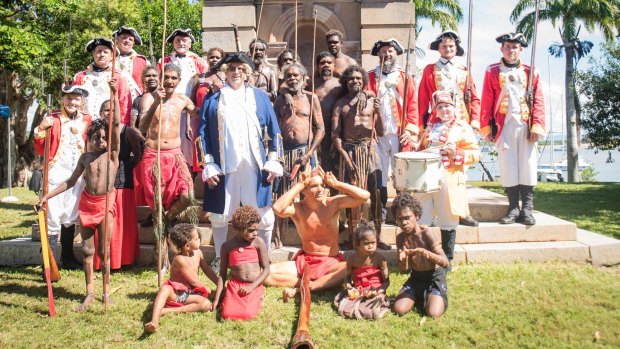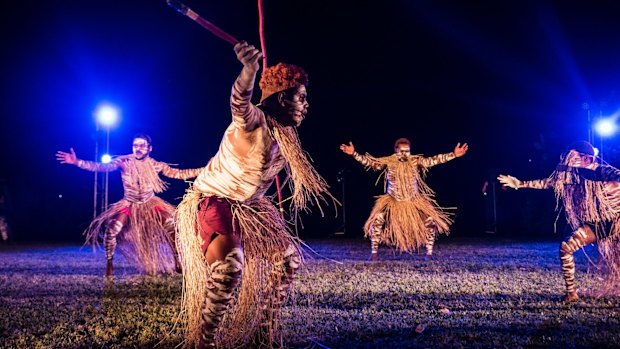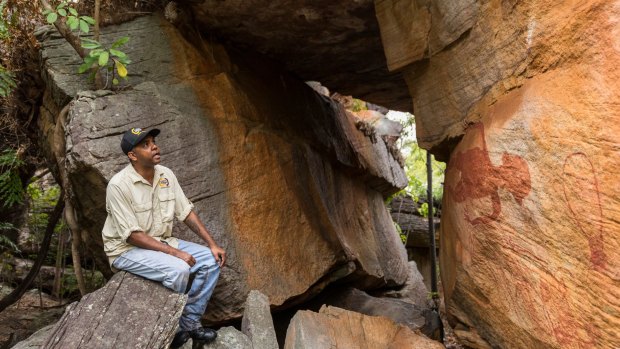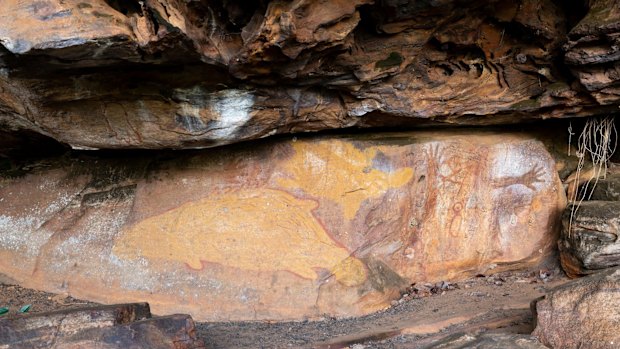This was published 4 years ago
Cooktown Discovery Festival, Queensland: History, art and the little-known tale of how Captain Cook became stranded
By Kerry van der Jagt

Rock art and re-enactment: 250 years after Captain Cook.
I'm standing at the entrance to a rock shelter, its ochre walls adorned with crocodiles, barramundi and long-necked turtles. A breeze swirls, stirring up the dust. Then I see him, a shadowy figure stretched sideways, thin and wispy like an apparition. I step closer, taking in the deformed head and elongated hands, each with seven sinewy fingers.
"This painting represents a sorcerer," says Dylan Harrigan, traditional owner and proud Balngarrawarra man. "It's possible he was causing harm to the families that once lived here."
Seeing such mysterious, culturally significant art – some of it 6000 years old – is extraordinary especially when Harrigan explains that I am one of the few white people to have ever walked this way. This is the inaugural Rock Art and Ranger tour of the season and he is justifiably proud. We follow hidden passageways – a maze that writhes like a Rainbow Serpent for some 40 kilometres – each connecting one painted gallery with another, most of them unmapped.

Injinoo Dancers during Cooktown Discovery Festival.
This is the homeland of the Balngarrawarra people, a region in south-east Cape York Peninsula, now recognised and protected as native title. "We have so many sacred sites out here, from ships and first contact art to initiation sites and burial grounds," says Harrigan. "The big question is, what do we showcase and what do we keep private?"
Harrigan is part of a wave of emerging Indigenous tour guides: passionate custodians of the world's oldest continuous living culture who are committed to offering contemporary tourism experiences on their homelands. With next year marking the 250-year anniversary of Captain James Cook's first voyage to Australia, his timing couldn't be more significant.
We'd set out from Cooktown a few hours earlier, following Battle Camp Road to Bull Creek before continuing on foot, over boulders, under sandstone ledges and across creeks. Red-tailed black cockatoos shriek overhead as Harrigan calls out to his ancestors, his voice one with the bush as he welcomes me to country. "This was a massive frontier," says Harrigan, referring to the violent conflicts between Indigenous Australians and white settlers during the late 1800s. "Our people fought back but eventually were driven off their land."

Dylan Harrigan inside rock shelter on Normanby Station.Credit: Kerry Trapnell
As we walk he shares his grandfather's stories, about how children as young as three would hide inside hollowed termite mounds to avoid capture by the colonists and about massacre sites, such as Battle Camp, where entire families were forced into the lake and shot.
I wonder, and not for the first time, where the official memorials are to these brave frontier warriors, who fought and died defending their homeland? I'd heard whispers about the Frontier Wars, but to walk where every river, tree and track still trembles with memory moves me like nothing else. For decades I've travelled to remote parts of Australia, to learn more about Indigenous culture, and about my own connection, through my maternal grandmother, to the Awabakal people from the mid-North Coast of NSW.
From the rock-art sites we head to Normanby Station where plans are being hatched to offer overnight accommodation, build a recording studio for Top End artists and to hold large-scale music concerts. Harrigan, together with his four brothers, are well-known for their band Black Image. A little bit reggae, a little bit rock and a whole lot of country, the band is another way the Harrigan's share stories and show respect for their homelands.

Rock art Normanby Station.Credit: Kerry Trapnell
An extension of this stewardship is the Indigenous Land and Sea Ranger program, a hands-on approach to rejuvenating the land after decades of cattle grazing, while simultaneously protecting The Great Barrier Reef from sediment. As part of the full-day Rock Art and Ranger tour we visit sites where Balngarrawarra rangers fence riverbanks to divert water from erosion gullies. I meet Greta – an erosion gully so large it has been named like a cyclone – her steep sides crumbling at my feet and threatening to pull me in like quicksand. "If we want to save the reef we have to start here," says Harrigan, letting the silty soil trickle through his fingers.
Back in Cooktown it's the eve of the Cooktown Discovery Festival, an annual event that marks the first (recorded) reconciliation between Indigenous Australians and Europeans. As every school child knows, Lieutenant (later Captain) James Cook's first landing on Australian soil was at Botany Bay in 1770. However, he stayed only for eight days; Cook and his crew spent 48 days on the south bank of the Waalumbaal Birri (Endeavour River) on the lands of the Guugu Yimithirr people after their ship, Endeavour, ran aground on a reef.
This first sustained contact was memorable for many reasons: 130 words of the Guugu Yimithirr language was recorded, 325 plant species were collected and their traditional uses recorded, and a skirmish over captured turtles was resolved between Cook and an elder. As Cook wrote in his journal, "We now returned the darts we had taken from them which reconciled everything."
What Cook didn't understand was that he'd landed on Waymburr, a sacred meeting place governed by a lore that dictated "no blood could be spilled in anger". The act of reconciliation by the elder was a call for calm to be restored on this safe haven.
The twist to this little-known tale is that it was Guugu Yimithirr culture that protected Cook and allowed him to continue safely on his journey. For the last 40 years this point has been highlighted during the annual three-day Cooktown Discovery Festival and re-enactment of the stranding, landing, conflict and resolution. Next year's three-week Cooktown Expo 2020 will be built around the concept of reconciliation between Indigenous and non-Indigenous Australians.
"Rather than a celebration of Captain Cook's landing, the focus will be on our shared history over the last 250 years," says Peter Scott, mayor of Cook Shire Council. "Ours is a positive story of mutual respect." Scott has been mayor for 11 years and there's not much he doesn't know, from the minute details of Cook's logs to the sacred lores of the Guugu Yimithirr people. "There's something special about this place," he says. "There's a natural and spiritual integrity, thanks to Waymburr." It doesn't take long before I feel the energy. On one evening I watch as an Indigenous dance group takes to the foreshore of the Endeavour River telling the Waymburr story as a scarlet sky turns the still water into molten lava. On another day, I visit Reconciliation Rocks, a poignant symbol of Cooktown and the power of reconciliation.
The festival program is all encompassing, from a guided bushwalk in the footsteps of Sir Joseph Banks, the naturalist who travelled with Cook on Endeavour, to a cooking demonstration with celebrity chef Mark Olive to a sunset cruise on the Endeavour River. The re-enactment, with its sensitive portrayal of Guugu Yimithirr society, leaves no doubt that Australia was occupied by a people with a rich and complex culture.
One afternoon I climb Grassy Hill, the views across the serpentine river little changed since Cook stood here looking for a safe passage. If I close my eyes and squint the river morphs into a sequined serpent: giver of life, protector of water and silent witness to millennia of history. Today, with leaders such as Harrigan and Scott, hopes are high for an inclusive and prosperous future.
FIVE INDIGENOUS FESTIVALS
LAURA DANCE FESTIVAL
Experience music, dance and cultural performances as more than 20 Cape York communities come together (July 3-5, 2020). See wanggnarra.org.au
QUANDAMOOKA FESTIVAL
A three-month celebration of culture, country and people on North Stradbroke Island (June 1- August 31, 2020). See quandamookafestival.com.au
CAIRNS INDIGENOUS ART FAIR
A three-day program showcasing the artistic diversity of Queensland Aboriginal and Torres Strait Islander cultures (July 10-12, 2020). See ciaf.com.au
GULF COUNTRY FRONTIER DAYS FESTIVAL
A coming together of Indigenous Australians and First Nations peoples from around the world (August, 2020). See thegulfcountryfrontierdaysfestival.com.au
KEEP THE FLAME OF CULTURE BURNING FESTIVAL
A four-day festival that travels between five Aboriginal and Torres Strait Island communities (July, 2020). See tropicalnorthqueensland.org.au
TRIP NOTES
Kerry van der Jagt was a guest of Tourism and Events Queensland.
MORE
FLY
Qantas, Jetstar and Virgin Australia fly to Cairns from Melbourne and Sydney, with connections to Cooktown with Hinterland Aviation. See qantas.com.au, jetstar.com.au, virginaustralia.com.au , hinterlandaviation.com.au
TOUR
Culture Connect's full-day Rock Art and Ranger tour (ex Cooktown) costs adults $259, children $199. cultureconnect.com.au
FESTIVAL
Cooktown Expo 2020 and 250th anniversary of Captain Cook, July 17-August 4, 2020. See cooktown2020.com
Sign up for the Traveller Deals newsletter
Get exclusive travel deals delivered straight to your inbox. Sign up now.